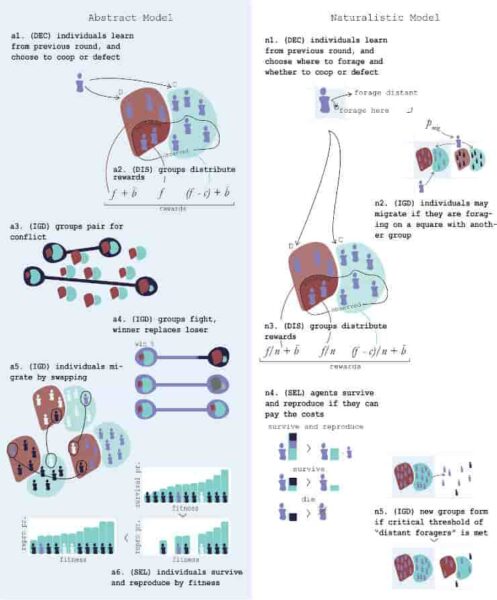According to a new study, the strong urge that many people feel to adhere to social norms, even when it is detrimental to themselves, may have its origins in Darwinian fitness.
The research uses agent-based modelling to provide an evolutionary mechanism that helps explain what keeps people cooperating even when no one is looking. It also points to new ways that humanity’s norm-internalizing tendencies could be harnessed to benefit societies, businesses, and other organizations.
“Even when only a minority of the population internalizes norms, it can have a big impact in terms of getting people to cooperate more and for longer. Our research offers an evolutionary explanation for why people will work together for the benefit of the group, even when it would be better for them, individually, not to do so,”
said lead author Victor Odouard, a former predoctoral researcher at the Santa Fe Institute.
Norm Internalizers
Previous modelling research has shown that a high level of norm internalization in a population can boost cooperation among groups of virtual agents evolving over time as they compete for resources. However, this previous research has generally assumed that there are a large number of norm internalizers in a population to begin with.
Norm internalization is the tendency to abide by the behaviour of the majority of the group, even when it is seemingly against the best interests of the individual.

Odouard and his Cornell University colleagues Diana Smirnova and Shimon Edelman, on the other hand, used an agent-based simulation in which population levels of norm internalizers and overall cooperation between groups of competing virtual agents began off low. They also allowed for the possibility of norm internalizers dying out if they could not compete with other selfish agent types.
Highly Cooperative Groups Win
The findings of their investigation indicate that individuals who internalize social norms tend to have higher survival rates at comparatively lower levels in relation to the broader community.
Nevertheless, this select group of norm internalizers creates a dynamic that leads to increased and sustained cooperation among other agents. This effect results in a small number of highly cooperative groups outcompeting other less cooperative groups for resources, enabling them to grow and spread.
“All you need is one group that has a lot of cooperators and suddenly that group is going to start outcompeting all the others,”
Odouard said.
Essentially, norm internalization produces a polarizing climate that allows the highly cooperative groups to decisively outcompete the less cooperative ones. As a result, there are more cooperative organizations and the rules they uphold.
Abstract
Many mechanisms behind the evolution of cooperation, such as reciprocity, indirect reciprocity, and altruistic punishment, require group knowledge of individual actions. But what keeps people cooperating when no one is looking? Conformist norm internalization, the tendency to abide by the behavior of the majority of the group, even when it is individually harmful, could be the answer. In this paper, we analyze a world where (1) there is group selection and punishment by indirect reciprocity, but (2) many actions (half) go unobserved and therefore unpunished. Can norm internalization fill this “observation gap” and lead to high levels of cooperation, even when agents may in principle cooperate only when likely to be caught and punished? Specifically, we seek to understand whether adding norm internalization to the strategy space in a public goods game can lead to higher levels of cooperation when both norm internalization and cooperation start out rare. We found the answer to be positive, but, interestingly, not because norm internalizers end up making up a substantial fraction of the population, nor because they cooperate much more than other agent types. Instead, norm internalizers, by polarizing, catalyzing, and stabilizing cooperation, can increase levels of cooperation of other agent types, while only making up a minority of the population themselves.
Reference:
- Odouard, V.V., Smirnova, D. & Edelman, S. Polarize, catalyze, and stabilize: how a minority of norm internalizers amplify group selection and punishment. Behav Ecol Sociobiol 77, 110 (2023). doi: 10.1007/s00265-023-03380-0
